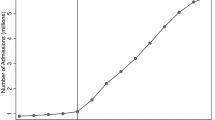Abstract
This paper estimates a more efficient version of an endogenous switching regression model to examine the effects of farmer education—schooling and extension contact—on cowpea production under traditional and improved technology in northern Nigeria. The results revealed significant productivity-enhancing effects of schooling and extension contact only under improved technology. Factors that promote technology adoption will thus indirectly raise the marginal contributions of farmer education; these include schooling, participatory technology evaluation, improved seed supply, and market access. The results demonstrate that schooling not only enhances agricultural productivity following technology adoption but also promotes adoption itself.
Similar content being viewed by others
References
Adesina AA, Zinnah M (1993) Technology characteristics, farmers’ perceptions and adoption decisions: a Tobit model application in Sierra Leone. Agric Econ 9:297–311
Ali M, Byerlee D (1991) Economic efficiency of small farmers in a changing world: a survey of recent evidence. J Int Dev 3:1–27
Appleton S, Balihuta A (1996) Education and agricultural productivity: evidence from Uganda. J Int Dev 8:415–444
Bindlish V, Evenson R (1997) The impact of T&V extension in Africa: the experience of Kenya and Burkina Faso. World Bank Res Obs 12:183–201
Birkhaeuser D, Evenson R, Feder G (1991) The economic impact of agricultural extension: a review. Econ Dev Cult Change 39:507–521
Feder GR, Just RE, Zilberman D (1985) Adoption of agricultural innovations in developing countries: a survey. Econ Dev Cult Change 33:255–298
Feder G, Lau LJ, Lin JY, Luo X (1990) The relationship between credit and productivity in Chinese agriculture: a micro-economic model of disequilibrium. Am J Agric Econ 72:1151–1157
Freeman HA, Ehui SK, Jabbar MA (1998) Credit constraints and smallholder dairy production in the East African highlands: application of a switching regression model. Agric Econ 19:33–44
Fuglie KO, Bosch DJ (1995) Implications of soil nitrogen testing: a switching regression analysis. Am J Agric Econ 77:891–900
Goetz SJ (1992) A selectivity model of household food and marketing behavior in sub-Saharan Africa. Am J Agric Econ 74:444–452
Greene WH (2000) Econometric analysis. Macmillan Publishing Company, New York
Hausman JA (1978) Specification tests in econometrics. Econometrica 46:1251–1272
Hausman JA (1983) Specification and estimation of simultaneous equation models. In: Griliches Z, Intriligator M (eds) Handbook of econometrics. North Holland Press, Amsterdam
Heckman J (1979) Sample selection bias as a specification error. Econometrica 47:153–161
Hossain S, Byerlee D (1995) Education and farm productivity in post-green revolution agriculture in Asia. In: Peters GH, Hedley D (eds) Agricultural competitiveness: market forces and policy choice. Proceedings of the 22nd international conference of agricultural economists, Harare, Zimbabwe. Dartmouth Publishing Company, Aldershot
Inaizumi H, Singh BB, Sanginga PC, Manyong VM, Adesina AA, Tarawali S (1999) Adoption and impact of dry-season dual-purpose cowpea in the semiarid zone of Nigeria. IMPACT, International Institute of Tropical Agriculture (IITA), Ibadan
Jamison DT, Moock PR (1984) Farmer education and farm efficiency in Nepal: the role of schooling, extension services and cognitive skills. World Development 12:67–86
Kormawa PM, Chianu JN, Manyong VM (2002) Cowpea demand and supply patterns in West Africa: the case of Nigeria. In: Fatokun CA, Tarawali S, Singh BB, Kormawa PM, Tamo M (eds) Challenges and opportunities for enhancing sustainable cowpea production. Proceedings of the world cowpea conference III, IITA, Ibadan
Kristjanson P, Tarawali S, Okike I, Singh BB, Thornton PK, Manyong VM, Kruska RL, Hoogenboom G (2002) Genetically improved dual-purpose cowpea: assessment of adoption and impact in the dry savanna region of West Africa. ILRI Impact Assessment Series 9. International Livestock Research Institute, Nairobi, Kenya
Lee LF (1978) Unionism and wage rates: a simulation equation model with qualitative and limited dependent variables. Int Econ Rev 19:415–433
Lockheed ME, Jamison DT, Lau L (1980) Farmer education and farm efficiency: a survey. Econ Dev Cult Change 29:37–76
Lokshin M, Sajaia Z (2004) Maximum likelihood estimation of endogenous switching regression models. Stata J 4(3):282–289
Maddala GS (1983) Limited dependent and qualitative variables in econometrics. Cambridge University Press, New York
Manyong VM, Smith J, Weber GK, Jagtap SS, Oyewole B (1996) Macro-characterisation of agricultural systems in West Africa: an overview. Resource and Crop Management Monograph No. 21. IITA, Ibadan
Moock PR (1981) Education and technical efficiency in small farm production. Econ Dev Cult Change 29:723–739
Negatu W, Parikh A (1999) The impact of perception and other factors on the adoption of agricultural technology in the Moret and Jiru Woreda (district) of Ethiopia. Agric Econ 21:205–216
Okike I, Jabbar MA, Manyong VM, Smith JW, Akinwumi JA, Ehui SK (2001). Agricultural intensification and efficiency in the West African savannas: evidence from northern Nigeria. Socio-economics and Policy Research Working Paper 33. International Livestock Research Institute (ILRI), Nairobi, Kenya
Owens T, Hoddinott J, Kinsey B (2001) The impact of agricultural extension on farm production in resettlement areas of Zimbabwe Working. Paper Center for the Study of African Economies, University of Oxford, UK
Phillips JM (1994) Farmer education and farmer efficiency: a meta-analysis. Econ Dev Cult Change 43:149–165
Shultz TW (1964) Transforming traditional agriculture. Yale University Press, New Haven
Shultz TW (1975) The value of ability to deal with disequilibria. J Econ Lit 13:827–896
Singh BB, Chamblis OL, Sharma B (1997) Recent advances in cowpea breeding. In: Singh BB, Mohan Raj DR, Dashiell KE, Jackai LEN (eds) Advances in cowpea research. IITA and Japan International Research Center for Agricultural Sciences (JIRCAS) co-publication. IITA, Ibadan
Welch F (1970) Education in production. J Politi Econ 78:35–39
Author information
Authors and Affiliations
Corresponding author
Rights and permissions
About this article
Cite this article
Alene, A.D., Manyong, V.M. The effects of education on agricultural productivity under traditional and improved technology in northern Nigeria: an endogenous switching regression analysis. Empirical Economics 32, 141–159 (2007). https://doi.org/10.1007/s00181-006-0076-3
Received:
Accepted:
Published:
Issue Date:
DOI: https://doi.org/10.1007/s00181-006-0076-3




